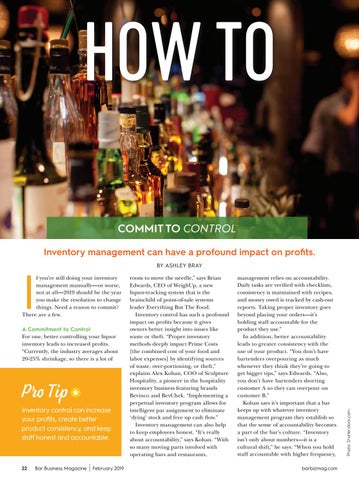How To
How To: inventory control
Commit to Control Inventory management can have a profound impact on profits.
I
f you’re still doing your inventory management manually—or worse, not at all—2019 should be the year you make the resolution to change things. Need a reason to commit? There are a few. A Commitment to Control For one, better controlling your liquor inventory leads to increased profits. “Currently, the industry averages about 20-25% shrinkage, so there is a lot of
Pro Tip Inventory control can increase your profits, create better product consistency, and keep staff honest and accountable.
22
Bar Business Magazine
room to move the needle,” says Brian Edwards, CEO of WeighUp, a new liquor-tracking system that is the brainchild of point-of-sale systems leader Everything But The Food. Inventory control has such a profound impact on profits because it gives owners better insight into issues like waste or theft. “Proper inventory methods deeply impact Prime Costs [the combined cost of your food and labor expenses] by identifying sources of waste, over-portioning, or theft,” explains Alex Kohan, COO of Sculpture Hospitality, a pioneer in the hospitality inventory business featuring brands Bevinco and BevChek. “Implementing a perpetual inventory program allows for intelligent par assignment to eliminate ‘dying’ stock and free up cash flow.” Inventory management can also help to keep employees honest. “It’s really about accountability,” says Kohan. “With so many moving parts involved with operating bars and restaurants,
management relies on accountability. Daily tasks are verified with checklists, consistency is maintained with recipes, and money owed is tracked by cash-out reports. Taking proper inventory goes beyond placing your orders—it’s holding staff accountable for the product they use.” In addition, better accountability leads to greater consistency with the use of your product. “You don’t have bartenders overpouring as much whenever they think they’re going to get bigger tips,” says Edwards. “Also, you don’t have bartenders shorting customer A so they can overpour on customer B.” Kohan says it’s important that a bar keeps up with whatever inventory management program they establish so that the sense of accountability becomes a part of the bar’s culture. “Inventory isn’t only about numbers—it is a cultural shift,” he says. “When you hold staff accountable with higher frequency,
February 2019 barbizmag.com
Photo: Shutterstock.com.
By Ashley Bray
